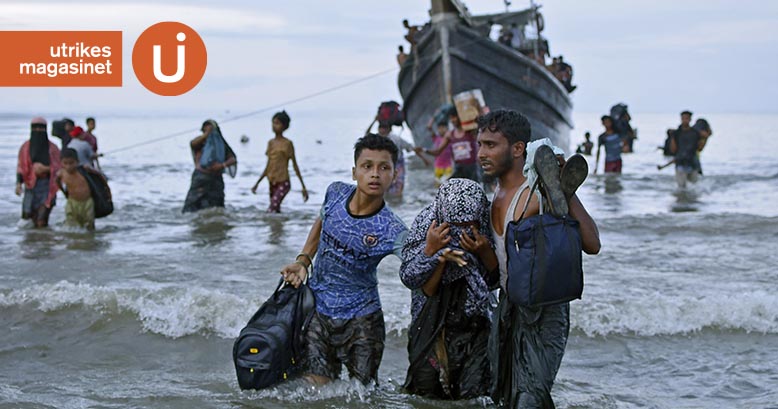
Myanmar’s conflict pushes junta to the brink and newly endangers Rohingya
Analysis. Three years after it imprisoned Aung San Suu Kyi’s elected government in a surprise coup, the Myanmar military looks weaker than any other time in the past 70 years. It has also stoked inter-communal tensions that are now threatening the persecuted Rohingya minority. China is the only international actor that wields significant influence among key actors in Myanmar, but it has taken an ambivalent position and there seems no end in sight for the conflict. By Paul Vrieze, Associate Fellow, UI's Asia Programme
Publicerad: 2024-05-30
Since late 2023, resistance forces have accelerated their offensives and taken over numerous military posts, strategic border areas and trade crossings with China, Thailand, India and Bangladesh, fragmenting the country into areas under control of the regime and a diverse range of resistance forces. The junta is estimated to have lost about half of its 5,280 outposts, bases and headquarters, according to an United States Institute for Peace expert. Its ground forces are so depleted by defections, casualties and surrenders that the military is struggling to hold or retake territory. The army, nonetheless, is unlikely to be overrun as it retains a vast Russian- and Chinese-procured arsenal and air superiority, which it uses to strike resistance targets and civilian structures in conflict zones, such as schools and Buddhist monasteries. So far this year, 375 airstrikes took place in 13 out of 15 states and regions in Myanmar, killing 255 civilians, according to Myanmar Peace Monitor.
Desperate for manpower, the junta launched a conscription drive in April 2024 that targets about 5,000 men in their late teens to mid-thirties per month (women are exempt for now). It is unclear how the conscription law will impact the strength of the army, but so far it has caused thousands of people to flee abroad or to join resistance forces, while others tried to bribe their way out. A 28-year-old doctor in Myanmar’s largest city, Yangon, told local news outlet Frontier that he closed his clinic and fled to areas in southeastern Myanmar controlled by a coalition of resistance forces to avoid conscription. “I thought that the revolutionary forces would help me… I had to inform my parents and say goodbye. They were worried and sad but didn’t stop me, because they don’t want to see their kid become a soldier and die,” he said.
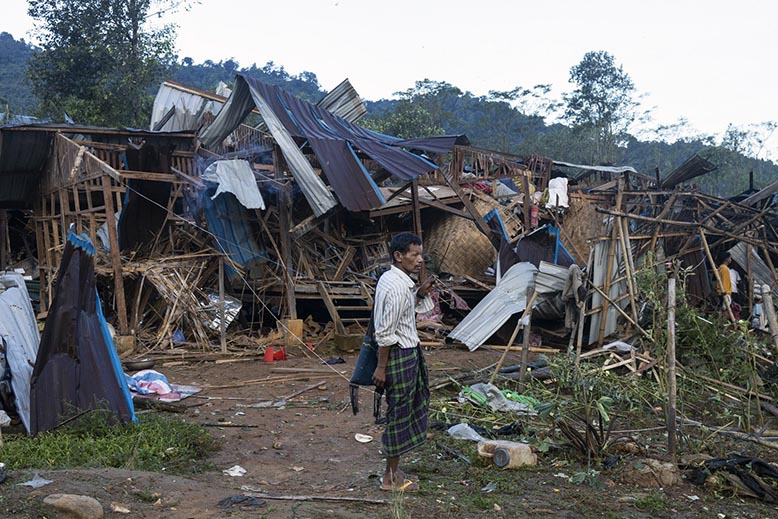 The military is accused of bombing civilians structures such as this displacement camp in Laiza, where the rebel Kachin Independence Army is also based. Photo: AP/TT
The military is accused of bombing civilians structures such as this displacement camp in Laiza, where the rebel Kachin Independence Army is also based. Photo: AP/TT
Young revolutionaries fighting for federal democracy
The military’s weak position is stunning considering that many resistance fighters were students and ordinary youths until spring 2021. Following the Feb. 1, 2021 coup, a huge protest movement emerged that gained support across Myanmar’s ethnically divided society by promoting an inclusive national identity and setting the goal of establishing a federal democracy. The movement is led by the National Unity Government that comprises a coalition of ousted National League for Democracy lawmakers, civil society, various strike groups, and four ethnic armed organizations based on Myanmar’s borders. Young protestors have been at the movement’s forefront and are outraged by the loss of relative freedoms they experienced during Myanmar’s decade-long democratic opening. Following a lethal crackdown on the demonstrations in March 2021, young protestors escalated tactics and organized improvised armed resistance with support from the coalition’s ethnic armed organizations.
Eventually, the wider movement began to support the surprisingly effective local resistance groups and the National Unity Government announced a national strategy to form local People’s Defense Forces (PDF). The strategy proved successful due to young PDF fighters’ strong motivation, skills in online crowdfunding and campaigning, as well as local arms production and innovative techniques such as the use of civilian drones to drop explosives on regime forces. The PDF forces, who are estimated at some 65,000 fighters, and allied ethnic armed organizations made significant territorial gains in central Myanmar’s Burman-majority areas and in northern, northwestern, and southeastern border areas that are home, respectively, to Chin, Kachin, Karen and Karenni minorities.
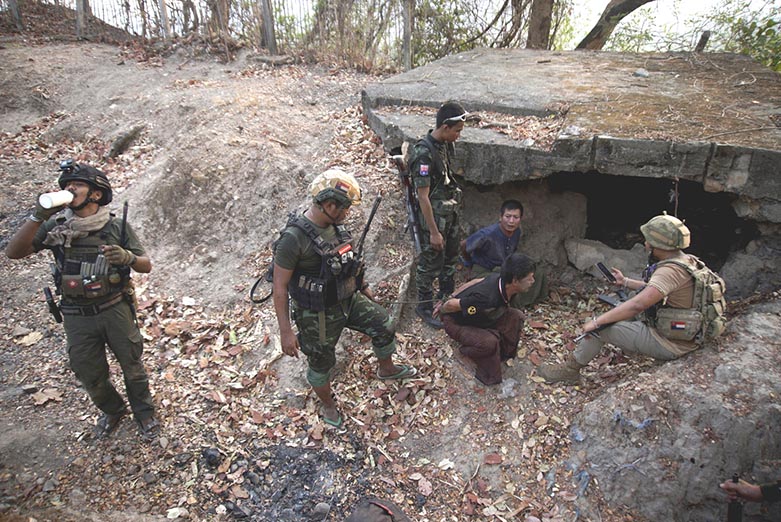 Members of the Karen National Liberation Army and People’s Defense Force examine two arrested soldiers after they captured an army outpost in Kayin state. Photo: METRO/AP/TT
Members of the Karen National Liberation Army and People’s Defense Force examine two arrested soldiers after they captured an army outpost in Kayin state. Photo: METRO/AP/TT
Other ethnic armed organizations come into the fray
While the National Unity Government-led coalition made significant military gains, other powerful ethnic armed organizations stayed outside the coalition and largely on the sidelines in the conflict. This changed in October 2023, when the Arakan Army, based in western Myanmar’s Rakhine State, and the Ta’ang National Liberation Army and Myanmar National Democratic Alliance Army, both based in Shan State on Myanmar’s northern-eastern border with China, launched a joint offensive against the junta. The groups swiftly conquered numerous military bases, towns, major roads, and important border crossings with China, inflicting the biggest defeat in decades on the army.
While the offensive, dubbed Operation 1027, was cheered on by the National Unity Government, the three groups do not share the coalition’s goal of establishing a federal democracy. Instead, they seek full political and military autonomy of their ethnic areas through an arrangement that is not necessarily part of a new democratic federation. The Arakan Army’s leader has pointed to the example of another powerful armed group, the United Wa State Army, which cut a ceasefire deal with the junta in 1989 that has allowed it to control a large, autonomous enclave in Myanmar, located on the border with China.
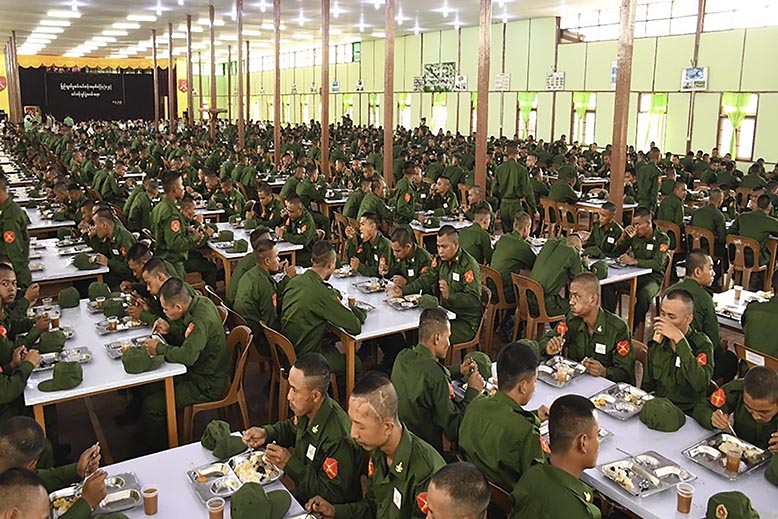 Opening ceremony for newly recruited trainees following the military's new recruitment campaign. Photo: Myanmar's army/AP/TT
Opening ceremony for newly recruited trainees following the military's new recruitment campaign. Photo: Myanmar's army/AP/TT
Rohingya trapped between conflict parties
In recent months, the Arakan Army has made steady military gains towards its objective and amid heavy fighting is poised to take control of the northern half of Rakhine State. The Arakan Army gathers support by promoting a nationalist agenda among the Rakhine Buddhist population. Trapped between the warring parties are the Rohingya, a Muslim minority of some 600,000 who mostly live in two townships on Rakhine’s northern border with Bangladesh. The Rakhine communities have been involved in violence against their Rohingya neighbors in 2012, while the Myanmar military has long persecuted the Rohingya, most notably during large-scale genocidal violence in 2017 that caused some 700,000 Rohingya to flee to Bangladesh.
The junta confines the Rohingya in their communities through repressive measures and it recently forcibly conscripted some 1,000 Rohingya men to fight against the Arakan Army, according to Human Rights Watch. The recruitment of Rohingya soldiers in the Myanmar army has heightened inter-communal tension. Arakan Army leaders have said the Rohingya community will be safe under its rule but warned that those who cooperate with the Myanmar army will face consequences. Rohingya rights advocates allege the Arakan Army has spread harmful rhetoric against the Muslim minority, killed some Rohingya and displaced tens thousands by burning down their homes after it conquered Buthidaung town in mid-May. The Arakan Army, in turn, claimed the Myanmar army was shelling and burning down Rohingya neighborhoods to foment local tensions.
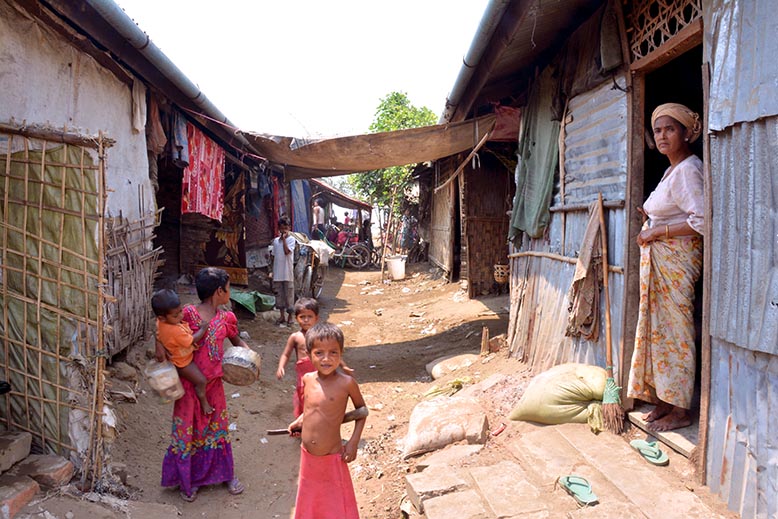 The Rohingya mainly live in two townships in Myanmar. Photo: Paul Vrieze
The Rohingya mainly live in two townships in Myanmar. Photo: Paul Vrieze
A spokesperson of the UN High Commissioner for Human Rights said on May 24 that both the Myanmar army and Arakan Army were involved in abuses against the Rohingya in recent weeks, but it did not confirm whose forces burned down Buthidaung. The spokesperson said: “We see clear and present risks of a serious expansion of violence as the battle for neighbouring Maungdaw town has begun -- where the military maintains outposts and where a large Rohingya community lives, including hundreds of displaced Rohingya who moved to town from villages seeking safety.”
The UN and the wider international community, however, have been unable to play a mediating role in Myanmar’s conflict, nor gained independent humanitarian access to some 3 million internally displaced persons. Until late 2022, there were hopeful signs for international diplomacy as UN Security Council members agreed on a resolution that called on Myanmar to uphold democratic institutions, and inclusive political process to resolve conflict and provide international humanitarian access. The resolution suggested the Association of Southeast Asian Nations (ASEAN) take a lead role in mediating the conflict, but the junta repeatedly rebuffed ASEAN’s ‘Five-Point Consensus Plan.” The National Unity Government, meanwhile, has focused on lobbying Western governments for support and recognition of the resistance coalition, with limited success.
China wields influence, but remains ambivalent
China has emerged as the only international actor to wield influence in Myanmar through its ties with both the military (which it has supported in the past), while it also has ties to powerful ethnic armed organizations outside the National Unity Government-led coalition. According to analysts, China was displeased by the coup as it had been developing warming relations with the Aung San Suu Kyi government, which was helping it secure its strategic interests in Myanmar. This includes a gas pipeline and railroad link from southern China to Myanmar ports and gas fields in the Bay of Bengal. The infrastructure allows Chinese energy and other supplies to bypass the Strait of Malacca, which is considered a vulnerable ‘choke point’ in case of conflict with the United States.
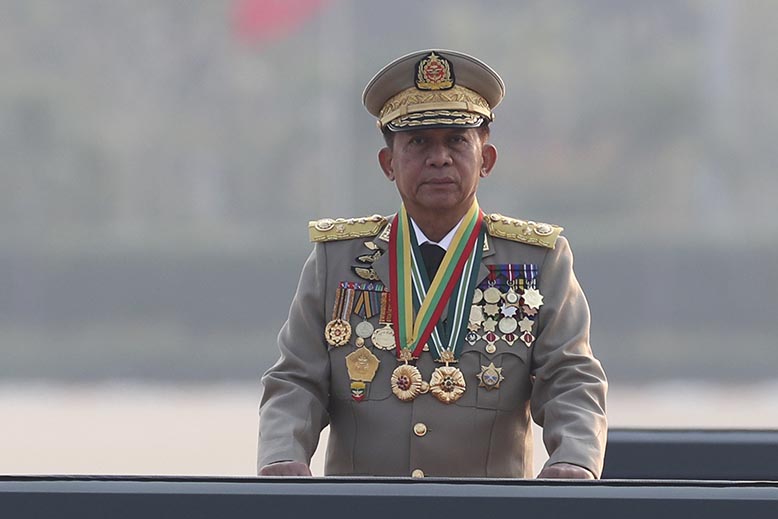 China was not keen on recognizing junta leader Min Aung Hlaing as head of state. Photo: Aung Shine Oo/AP/TT
China was not keen on recognizing junta leader Min Aung Hlaing as head of state. Photo: Aung Shine Oo/AP/TT
After the coup, China diplomatically engaged and allowed important trade with the junta, but declined to recognize its leader Min Aung Hlaing as head of state. Beijing then became increasingly annoyed with the regime’s failure to stamp out online scam centers operating under protection of local, army-backed militias in northern Myanmar. The scammers defrauded Chinese nationals on a large scale in recent years. The joint offensive that began in northern Myanmar in late 2023 by the Myanmar National Democratic Alliance Army, Ta’ang National Liberation Army and Arakan Army was thought to have China’s tacit support, as the groups claimed to be fighting both the regime and to wipe out criminal scam centers. Thousands of scam center suspects were eventually handed to Chinese authorities by both ethnic armed organizations and, later, the junta.
After ethnic armed organizations took over the Kokang border region following several months of fighting, China facilitated talks between the sides that yielded a tenuous truce in northern Myanmar, though the Arakan Army has continued to fight in Rakhine State. An International Crisis Group report suggested China will continue its ambivalent approach of managing its leverage with both the regime and resistance forces to maintain its geopolitical interests in Myanmar without seeking a comprehensive solution, making it likely that the conflict will drag on. But China is likely to offer support to the junta if it were to face collapse, according to the report, “lest it be replaced by the Western-leaning [National Unity Government] or some other configuration of a broadly anti-China resistance movement.”